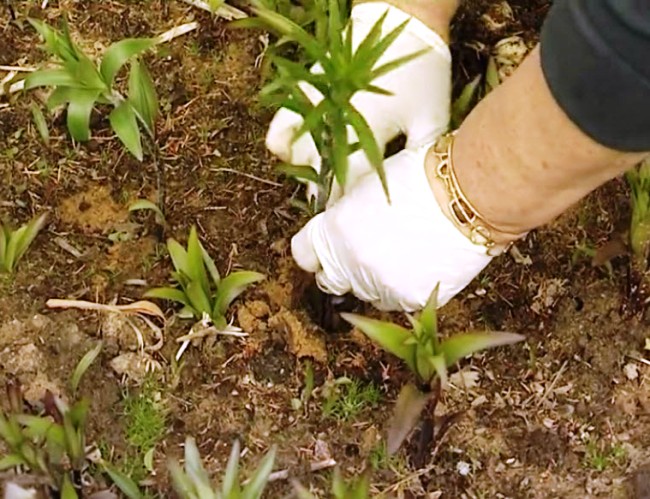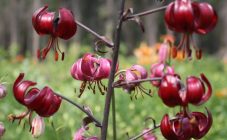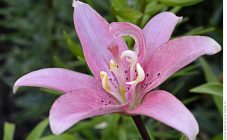Content:
The pyramidal lily belongs to the Asian hybrids. Their properties are enhanced shoot formation. With the growth of such colors, several growth points can be connected. Plants spliced in this way form a very wide peduncle in the form of a ribbon covered with ribs. In this case, the stem can twist around its axis or bend unnaturally. The number of buds on one peduncle in this case increases significantly.
This phenomenon does not apply to any particular type of lily. In agricultural technology, the phenomenon is called "fasciation" - from the Latin word "strip". Therefore, the opinion arose that the plants grown in this way are a new species. This is not true.
A large number of flowers on one peduncle, simultaneously opened, arises from the fact that many shoots grow from one fruit, growing together into a single peduncle. The appearance of such a flower is accidental, but the phenomenon is inherent in the variety of Marlene lilies.
Pyramidal lily - general information
The plant belongs to the Liliaceae taxonomic family. Perennial plant, reproduction takes place by bulbs. Leaves are arranged spirally around the stem. A bud is formed near the lowest leaf, which, as it grows, turns into a bulb. A young bulb begins to bloom the next season.
The perianth consists of 6 loose leaves, united by a funnel or a bell. Near the base of the bud there are cracks in which the glandular tissue secreting juice is located. Pollination is carried out by insects. Bees flock to the juice secreted by glandular tissues.
Characteristics of varieties
The Marlene variety belongs to Asian hybrids. Well resistant to low temperatures. Flowering occurs very early, takes root quickly. The stem can be up to a meter long. The leaves of the plant are very narrow and long. The flowers are large, the color from the center to the petals is darker. The flowering period can be up to two months. The shape of the bud is cup-shaped (not spherical). They are completely odorless, so they can be planted next to any plants.
Asiatic lilies can also form a pyramid of flowers. A variety bred by crossing can change in length depending on conditions. The height of the Asian pyramidal lily can reach one and a half meters. While dwarf lilies are barely half a meter. Flowers are cupped or turban-shaped, of considerable size.
American pyramidal lilies are also crosses of several different varieties. The flowers are extremely cold resistant. American lilies do not withstand transplanting well. Growing requires soil with a pH in the range of 6-7 and plenty of groundwater. Flower petals may vary depending on the subspecies.
Martagon lilies are distinguished by a wide variety of species. Easy to care for, they have a large number of shades. The lily bush grows to a large size, therefore they are planted in the soil in groups.
The Candidum lily variety is also a hybrid form. The ancestors were royal flowers. Differs in extreme demands on care and weak protection against diseases and parasites. The color palette is mostly pink or white. Some flowers can also be pale purple.
Lily pyramidal: planting and care
Plants are planted in open soil in mid-spring. If the seedlings were purchased in the fall, keep the bulbs in the refrigerator until early May.
Landing is done 20 centimeters into the ground. If the soil is clayey, you must first fertilize it. The loam is enriched with humus, peat or sand. Clay, peat and humus must be added to the sandstone. Fresh manure is prohibited. Young bulbs can die because of it.
Plant care:
- water moderately, at the root, 3-4 times a week;
- shoots are fed three times: during planting, fertilizers with nitrogen are needed, when buds appear, complex feeding will be required, after the flowering period it is necessary to allow the plants to be saturated with phosphates and potassium compounds;
- the soil needs to be loosened from time to time;
- if the stem is high, you need to tie it to the support;
- bulbs are transplanted three times a year. After flowering, the daughter bulbs are separated from the mother ones, in the spring they are planted in the holes.
Major diseases and pests
Lily pyramidal is attacked by the following diseases and pests:
- fungal diseases (botrytis, fusarium, cercospora, anthracnose, rhizoctroniasis, phytium, blue mold, penicillosis, rust);
- viral diseases (cucumber and tobacco mosaic, variegation, rosette);
- parasites (spider mite, squeak beetle, lily fly, bear, beetle, wireworm, etc.);
Lilies are complex, disease-prone plants. However, if properly looked after, taking into account all the norms and treatment from pests, they will provide the front garden with a large number of beautiful flowers. In some varieties, the crops can grow together, forming a huge peduncle with many flowers - a pyramidal lily. However, this phenomenon is accidental, depends on the use of stimulants, environmental conditions, and sometimes arises from plant diseases.















